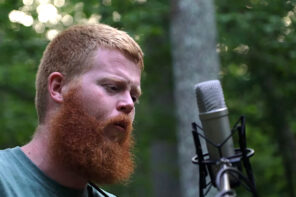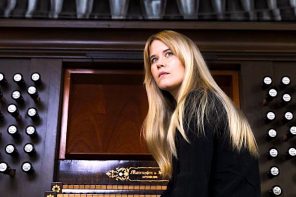So, about that Chrysler “Imported from Detroit” Super Bowl ad with Eminem that’s been the focus of so much heated discussion. I can’t speak to the implications of the ad for the American car industry, nor for Eminem’s career, but not too long after I first saw the spot on the internet, I started thinking about the black gospel choir that shows up near the end. Though the choir figures only briefly in the spot, it is far more than background noise. Indeed, the more I watched and rewatched the video, the more I was struck by how central the choir’s subtle but significant presence is to the overall effect that the ad is trying to achieve—and how the pop-culture ubiquity of the black gospel choir belies its complicated cultural capital.
A Heavenly Host
The first ninety seconds of the two-minute spot are devoted to a jauntily edited series of video clips taken from a car ride into the heart of Detroit. At the same time, a gravelly-voiced offscreen narrator directly addresses the audience about the apparent paradox of a gritty, hardscrabble city like Detroit—one “that’s been to hell and back”—knowing anything “about the finer things in life,” like luxury automobiles: “I gotta question for you,” the narrator says, “what does this city know about luxury, huh?” As this monologue proceeds, we realize this is no ordinary car ride, but one involving a shiny new Chrysler (the new Chrysler 200, as it turns out) driven by Eminem, a Detroit native.
As the car moves deeper and deeper into the city, a hum that seems to emerge from the sounds of the city itself begins to cohere into a discernible soundtrack: first a pulsating rhythm, then a driving guitar riff, and ultimately a chorus of voices vocalizing around the instrumentation on a minor-ish theme (the music is from Eminem’s “Lose Yourself”).
In the ad’s closing sequence, as the music swells and voices rise, Eminem enters Detroit’s historic Fox Theater and saunters with histrionic nonchalance down the center aisle of the vast, opulent space. It is empty but for a black gospel choir on stage singing—the same choir, we are led to believe, that we’ve been hearing all along.
The stage is backlit, and cloud-like smoke billows gently upward behind the singers, giving the impression of heraldic messengers trailing clouds of glory in their journey from on high. As the rapper takes the stage, the chorus crescendos, breaks off abruptly, and then resumes vocalizing in a low, reverent hum, all heads bowed, as if in deference and awe. Enveloped in this reverential aura, Eminem swivels toward the camera, points his finger at us, and intones—Uncle-Sam style—“this is the Motor City, and this is what we do.”
Whatever “this” is meant to be exactly, the host of herald angels framed in the background of this final scene testifies to the depth of feeling we are clearly meant to experience. In this case, the part of angels goes to The Selected by God Choir, but my interest was sparked not so much by this particular chorus (though they sing with great power and beauty) as in the way the black gospel choir is pivotal to conveying the aesthetic seriousness and conceptual profundity to which the ad aspires. Which is to say, the ad is most interesting to me for the way it illustrates the black gospel choir’s power as a multi-purpose psychosocial cipher in American pop culture.
Turning Gospel into a National Resource
As it appears in mainstream America today, the black gospel choir—in most cases a paraprofessional group of performers that may record albums, tour nationally, or turn up singing in car commercials—is a phenomenon of the post-Civil Rights twentieth century. But of course the black gospel choir as a musical formation and cultural icon reaches back much farther.
As it comes to us now, the gospel choir evokes the cultural function of black churches as the cornerstone of community for newly-emancipated slaves in the years after the Civil War, as a source of strength for the struggle in the Jim Crow era, and as the locus of nonviolent resistance during the Civil Rights Movement. More than just songs of consolation that consecrated the modern African American experience, the music that rang out in these churches re-voiced centuries-old expressive traditions—the work songs, field hollers, ring shout, and other Africanisms—that were encoded into slavery and the religious practices of slaves in the Americas from the very beginning.
Much of what is considered stylistically distinctive about black gospel today derives at some level from its links to the history of oppression and overcoming that has long defined the African American experience. There is a certain world-historical gravitas to this music that, when it’s good, commands a virtually unquestioned aesthetic authority in mainstream culture.
This attitude toward black gospel choirs has been especially prominent in mainstream America since the Civil Rights Movement. The galvanizing role that mass singings of “We Shall Overcome” and other reworked spirituals played in the public struggle for Civil Rights redefined black gospel music in the popular imagination as not simply the sacred song of black churches but the soundtrack for democracy’s slow but steady march toward greater freedom and equality in the modern era. In the process, black gospel was effectively nationalized as an American cultural resource.
Many stars of R&B, Motown, and Soul music who rose to prominence in the ’60s and ’70s got their start singing in church. These artists regularly made a point of explicitly incorporating the sounds and styles of the African American sacred tradition, as in Aretha Franklin’s 1972 live album, Amazing Grace. Recorded with the Rev. James Cleveland and the Southern California Community Choir at the New Temple Missionary Baptist Church in Los Angeles, the album remains Franklin’s most popular. And as Franklin and other artists from this era went out of their way to foreground their musical roots after achieving enormous secular fame and success, the black gospel choir became synonymous in the mainstream American imagination with the sound of overcoming historical injustice.
The Warm Glow of the Gospel Aura
Ever since then, and perhaps unsurprisingly, Anglo-American pop culture has been drawn to the use of black gospel choirs as a means of accessing the vast cultural capital associated with this music. When a black gospel choir willingly participates in mainstream American music or mass-market advertising or Hollywood films, the music shrouds everyone and everything around it in the warm glow of the gospel aura, but without explicitly dredging up America’s sordid history of slavery and racism.
Consider The Blues Brothers (1980), arguably one of the earliest and most prominent mainstream products of American pop culture to include a black gospel choir in the way I am trying to describe. Early on in the film, “Joliet” Jake Blues (John Belushi) knocks around Chicago with his brother, Elwood (Dan Akroyd), trying to figure out what to do as a newly released ex-con. Soon enough, he has an epiphany: he and his brother should restart the R&B band they formed before Jake went to prison and use the proceeds from the band’s gigs to save the orphanage where the brothers grew up. When he has this revelatory insight, Jake isn’t listening to a barbershop quartet or the Mormon Tabernacle choir or the Ray Conniff Singers. He is standing dumbfounded and awestruck in the presence of the Triple Rock Baptist Church Choir, backing the Rev. Cleophus James (James Brown), singing the gospel standard “The Old Landmark.”
For this scene to work, even or especially as musical comedy (and it does, despite drifting uncomfortably close to minstrelsy at times), the film relies on a cultural logic common to most appearances of a black gospel choir in post-Civil Rights pop culture: that black gospel is a universal language of inspiration and transcendence that cuts across race, class, and history.
This logic has proven remarkably adaptive to a range of postmodern pop cultural contexts:
There’s the final chorus of Foreigner’s 1984 power ballad, “I Wanna Know What Love Is,” which features the New Jersey Mass Choir. The choir’s warm, expansive harmonies take a garden-variety power ballad (“I wanna know what love is / I want you to show me… / Aaaah woah-oh-ooh”) and transform it into a secular anthem of the ever-yearning heart.
There’s U2’s “I Still Haven’t Found What I’m Looking For” on the 1988 live album Rattle and Hum. The black gospel choir here turns the song into a kind of existentialist manifesto set to music.
There’s Sister Act II (1993), with Lauryn Hill (before her “Miseducation”), which includes one of the most affecting renditions of “His Eye is on the Sparrow” (with Tanya Blount) that I’ve ever heard. The centerpiece of the film features Hill’s character leading a multicultural choir of fictional orphans in a kumbaya-style performance of “Joyful, Joyful We Adore Thee,” arranged in the black gospel tradition.
There’s the powerful scene in the film Angels In America (2003), in which a fabulous drag queen, backed by a swaying, enrobed, and equally fabulous black gospel choir, memorializes a gay man who has died of AIDS with a rousing performance of Zella Price Jackson’s exuberant “I’m His Child.” Here, the effect of the black gospel choral style is to implicitly link the gay-male social struggle against homophobia with the soul in bondage striving after the salvation of freedom in the Civil Rights era.
And then there are any number of other mainstream movies that in one fashion or another use the crossover hit, “Oh Happy Day,” what one reader at my blog aptly suggested could be retitled “the only black gospel song Hollywood knows.” For only one of the most recent examples of this phenomenon, see Disney’s Secretariat (2010), in which a montage overlaid with a black gospel choir singing “Oh Happy Day” reinforces the film’s commitment to what Manohla Dargis describes as the “Disney gospel”: the “meaning of life is following your dreams.”
In one way or another and to varying degrees of success, all these examples (and many others like them) invite audiences to imagine themselves as part of a color-blind fellowship of humanity bound together by the soulful sound of a black gospel choir.
“This Is What We Do”
There is nothing necessarily wrong with this kind of uplifting grand narrative. But I’m not the only one to wonder what can be lost in the process. As Lester Spence has noted of that Chrysler Super Bowl ad, the uplifting presence of the black gospel choir backing a white rapper in Detroit glosses over the crippling inequalities of race and class in the city. To this I would only add that, whether intentionally or not, the ad also does nothing to discourage viewers from believing that “this”—this romanticized image of a city without any visible evidence of race-based conflict or inequality, where black people reverentially bow their heads en masse when a famous white man walks on stage—“this is the Motor City, and this is what we do.”
In this process, the very real racial tension surrounding the struggle for equality of opportunity in America isn’t so much resolved or reconciled or even recognized. It is simply ignored in these digestible little pageants of musical and psychosocial harmony.
The conventional wisdom about trends suggests that having been identified, this particular pop cultural tendency is now destined to fade. Maybe, maybe not. But there are signs the black gospel choir as pop culture fixture has become so fully assimilated into the contemporary pop culture psyche as to have become the object of and vehicle for that most postmodern of modes: ironic humor.
In its 100th episode, the hospital sitcom Scrubs included a bit that involved a black gospel choir (Laverne’s Gospel Choir to be exact) showing up from behind a privacy curtain to sing “Payback is a Bitch” to Zach Braff’s character.
More recently, after the show South Park received death threats for including depictions of the prophet Mohammed, Jon Stewart’s Daily Show denounced “anyone who’s threatening death in the name of religion or politics.” Then, as Stewart recounted to Terry Gross, “a gospel group came out and sang ‘go (bleep) yourselves.’”
“And can I tell you the most difficult thing about that?” Stewart concludes. “Finding a gospel group that’ll sing, ‘go (bleep) yourself.’”
Difficult, but not impossible. This, too, it seems, is what we do.
The author is particularly grateful to the readers of his blog (and a few Facebook friends) for their crowdsourcing assistance in the writing of this article.




